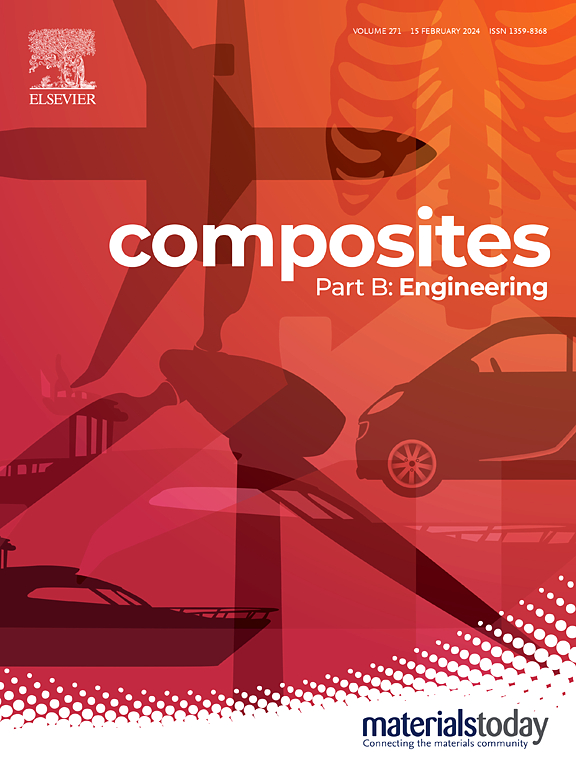Orthogonal orientation incorporated gradient-sandwich structure for enhanced energy storage performance of all-inorganic nanocomposites
IF 12.7
1区 材料科学
Q1 ENGINEERING, MULTIDISCIPLINARY
引用次数: 0
Abstract
Dielectric energy storage capacitors, widely used in advanced domains of electronics and power, play a crucial role in electronic systems. However, current challenges stem from the coupled limitations of polarization and breakdown field strength in dielectric capacitors, which present significant obstacles to achieving a breakthrough in energy storage performance. Here, we propose an orthogonal design for all-inorganic nanocomposite using innovative composite molding techniques. The increased path tortuosity is tailored during the electrical treeing process through the orthogonal distribution of ferroelectric nanofillers, ensuring the preservation of high breakdown strength and polarization. Meanwhile, a gradient-sandwich multilayer configuration is developed to leverage the interfacial polarization effect and interface barrier effect between adjacent layers. Hence, integrating a gradient electric field distribution enhances both the polarization and breakdown strength of the nanocomposites, ultimately resulting in a significant improvement in energy storage performance. The ultrahigh energy density of 24.5 J cm−3 at a low electric field of 1700 kV cm−1 is obtained in orthogonal orientation gradient-sandwich structure ≈1.8 times that of the parallel filler orientations nanocomposites. Incorporating the orthogonal orientation and gradient-sandwich structure strategy significantly enhances energy output, making it suitable for a wide range of electronic devices.
正交取向结合梯度夹层结构增强了全无机纳米复合材料的储能性能
介质储能电容器广泛应用于电子、电力等先进领域,在电子系统中起着至关重要的作用。然而,目前的挑战源于介质电容器的极化和击穿场强的耦合限制,这对实现储能性能的突破构成了重大障碍。在这里,我们提出了一个正交设计的全无机纳米复合材料使用创新的复合成型技术。在电树过程中,通过铁电纳米填料的正交分布来定制增加的路径弯曲度,确保保持高击穿强度和极化。同时,为了充分利用相邻层之间的界面极化效应和界面势垒效应,提出了一种梯度夹心多层结构。因此,集成梯度电场分布可以增强纳米复合材料的极化强度和击穿强度,最终显著提高储能性能。在1700 kV cm−1的低电场下,正交取向梯度-夹层结构获得了24.5 J cm−3的超高能量密度,是平行填料取向纳米复合材料的1.8倍。结合正交取向和梯度夹层结构策略,显著提高了能量输出,使其适用于各种电子器件。
本文章由计算机程序翻译,如有差异,请以英文原文为准。
求助全文
约1分钟内获得全文
求助全文
来源期刊

Composites Part B: Engineering
工程技术-材料科学:复合
CiteScore
24.40
自引率
11.50%
发文量
784
审稿时长
21 days
期刊介绍:
Composites Part B: Engineering is a journal that publishes impactful research of high quality on composite materials. This research is supported by fundamental mechanics and materials science and engineering approaches. The targeted research can cover a wide range of length scales, ranging from nano to micro and meso, and even to the full product and structure level. The journal specifically focuses on engineering applications that involve high performance composites. These applications can range from low volume and high cost to high volume and low cost composite development.
The main goal of the journal is to provide a platform for the prompt publication of original and high quality research. The emphasis is on design, development, modeling, validation, and manufacturing of engineering details and concepts. The journal welcomes both basic research papers and proposals for review articles. Authors are encouraged to address challenges across various application areas. These areas include, but are not limited to, aerospace, automotive, and other surface transportation. The journal also covers energy-related applications, with a focus on renewable energy. Other application areas include infrastructure, off-shore and maritime projects, health care technology, and recreational products.
 求助内容:
求助内容: 应助结果提醒方式:
应助结果提醒方式:


